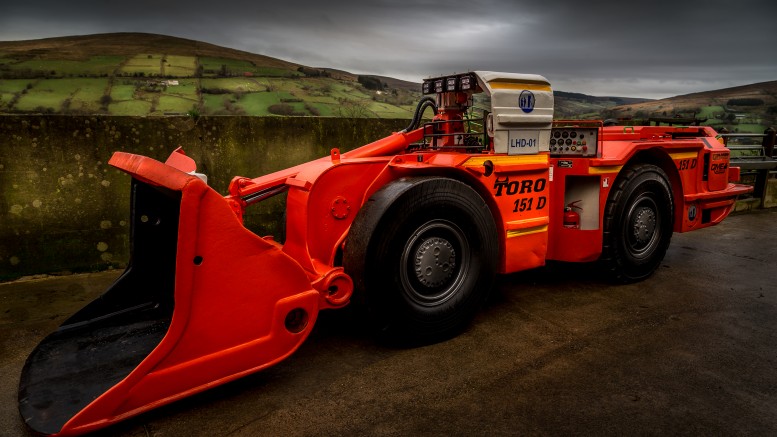VANCOUVER — Dalradian Resources (TSX: DNA; US-OTC: DRLDF) has completed a feasibility study at its high-grade Curraghinalt gold deposit, 127 km west of Belfast, Northern Ireland, that models a 1,400-tonne-per-day underground operation.
The company has spent the past year improving confidence in its reserves, including a test-stoping program that returned higher grades than predicted by current resource models.
The study is the first major update since a preliminary economic assessment in late 2014. The company has cut the mine production rate from 1,700 tonnes per day under the previous study, which has dropped average anticipated gold production from 194,000 oz. to 130,000 oz. per year.
The updated plan models life-of-mine gold production of 1.36 million oz. gold over 10.5 years at all-in sustaining cash cost of US$674 per oz. gold. The smaller scale allows for lower preproduction capital costs, which have declined US$80 million to US$192 million.

Standing in an adit at Dalradian Resources’ Curraghinalt gold deposit in Northern Ireland. Credit: Dalradian Resources.
Proven and probable reserves stand at 5.2 million tonnes grading 8.54 grams gold per tonne and 3.9 grams silver per tonne for 1.44 million contained oz. gold and 664,000 contained oz. silver. Measured and indicated resources total 5.6 million tonnes at 11.61 grams gold for 2.1 million contained oz. gold.
The Curraghinalt deposit is an orogenic gold system consisting of moderately to steeply dipping, structurally controlled, high-grade gold-bearing quartz-carbonate veins.
The reserve and resource calculations incorporate over 50,000 metres of infill drilling and underground samples from drifts along the T17, Sheep Dip, 106-16, V-75, Slap Shot and No. 1 vein zones.

Channel sampling at Dalradian Resources’ Curraghinalt deposit in Northern Ireland. Credit: Dalradian Resources.
“This study has taken us over a year to complete and incorporates a lot of underground work, including test stoping, sampling and drilling,” Dalradian president and CEO Patrick Anderson said during a conference call. “We’re completing our environmental applications, and from the moment we submit our planning application the legislated timeline for putting it through is around one year.
“We’ve only drilled off part of the deposit. The study considers only part of our global resources, and stepping out to the east and the west we can see areas where we’ve drilled veins, but not with enough density to incorporate into a mine plan. So we see a lot of upside and blue sky out there,” he said, adding that Curraghinalt also has 7.1 million tonnes of 10.06 grams gold for 2.3 million oz. in the inferred category.
The mine plan features a US$301-million after-tax net present value at a 5% discount rate, along with a 24.4% internal rate of return. Economic calculations are based on a US$1,250 per oz. gold price.
Curraghinalt would be accessed with an existing exploration adit and a new ramp next to the plant site. Annual ore production is planned from a primary longitudinal long-hole retreat, with cut-and-fill along the veins.

Northern Ireland’s Minister for Enterprise, Trade and Investment, Arlene Foster MLA, and Dalradian Resources CEO, Patrick Anderson, during a visit to Curraghinalt in August 2014. Credit: Dalradian Resources.
The proposed processing circuit involves a crush, grind, flotation and leach flow sheet to recover gold and silver into doré. Metallurgical test work indicates life-of-mine gold and silver recoveries of 94% and 58%.
“We had two public events last month where 270 people attended. We had a lot of good questions because it’s a new industry to the area. The strong project economics will help carry us through, however, and we’ve incorporated a lot of community feedback into our design,” Anderson said.

“This study has taken us over a year to complete and incorporates a lot of underground work.”
Patrick Anderson
President & CEO
Dalradian Resources
Curraghinalt has been designed to fit in with the topography, incorporating a low-profile architecture and added trees, berms and sound panels to buffer noise.
Using cyanide could prove a sensitive issue locally, though tailings from the flotation circuit — which will not have come into contact with cyanide — are to be filtered and placed as dry-stack material.
Anderson says the time line for permits could reach three years if regulators recommend more public inquiries and a judicial review.
Dalradian is applying to carry out a public local inquiry to streamline permitting. The company is working on its environmental and social impact assessment, which would likely be filed next year.
BMO Capital Markets analysts Andrew Mikitchook and Andrew Breichmanas have an “outperform” rating on Dalradian shares along with a $1.34-per-share price target. BMO Research speculates that Curraghinalt “can be mined at high grades, low costs and at a manageable capital cost,” but assumes “modest uncertainty in the permitting progress.”
Dalradian shares have traded in a 52-week range of $1.16 to $1.21 per share, and closed at $1.18 at press time. The company has 242.5 million shares outstanding for a $275-million market capitalization. It reported US$40 million in net working capital at the end of September.


Be the first to comment on "Dalradian tables feasibility study for Curraghinalt"